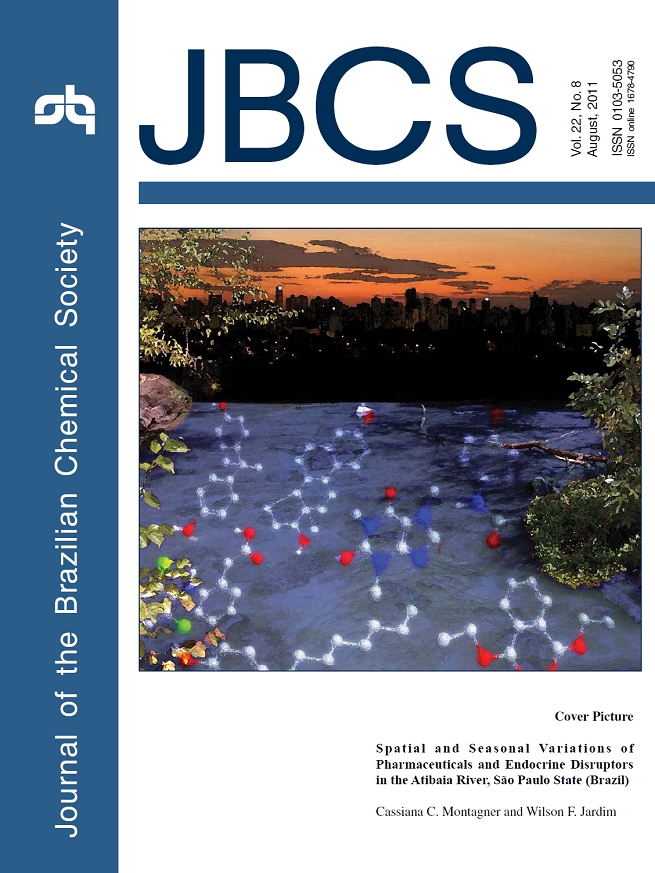vol. 22, No. 8, 2011, p. 1395-1615
Emerging contaminants refer to compounds present in different environmental compartments, both man-made and naturally occurring, as well as other substances and their degradation products, not previously recognized adverse effects on ecosystems and not considered under the current legislation regulating drinking water quality. Several groups of compounds have emerged as particularly relevant; among them, pharmaceuticals, personal care products, surfactants and their metabolites, plasticizers, natural and synthetic estrogens. Some compounds are of particular concern due to the fact that they can alter the functioning of the endocrine system of animals and humans chronically exposed to them. The input of sewage and effluents are the major contributors to the contamination of the water bodies by these substances. Conventional wastewater treatment plants are not efficient in removing some of these compounds, so they may be present in our drinking water resources.
Details are discussed in the article Spatial and Seasonal Variations of Pharmaceuticals and Endocrine Disruptors in the Atibaia River, S
(Read more at Editorial)
Editorial J. Braz. Chem. Soc. 2011, 22(8), 1395-1398
Review J. Braz. Chem. Soc. 2011, 22(8), 1399-1406
Photocatalytic Production of Hydrogen: an Innovative Use for Biomass Derivatives
Marcos de Oliveira Melo; Luciana Almeida Silva
How to cite this article

The photocatalytic reforming of aqueous biomass solutions could be an interesting and innovative route to produce hydrogen in ambient conditions. This process is able to produce hydrogen from renewable energy sources, since it uses solar radiation, raw materials derived from renewable sources such as biomass and water.
https://dx.doi.org/10.1590/S0103-50532011000800002
Articles J. Braz. Chem. Soc. 2011, 22(8), 1407-1417
Chitosan/Siloxane Hybrid Polymer: Synthesis, Characterization and Performance as a Support for Immobilizing Enzyme
Grazielle S. Silva; Pedro C. Oliveira; Domingos S. Giordani; Heizir F. de Castro
How to cite this article
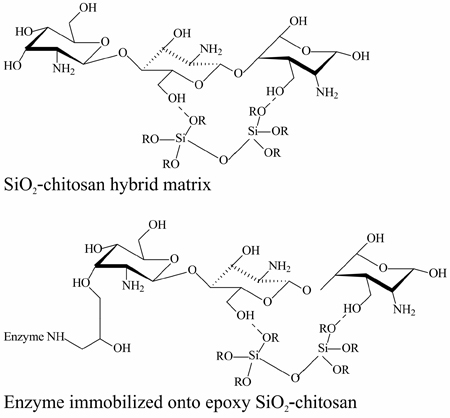
The performance of a silica/chitosan hybrid matrix synthesized by sol-gel process was evaluated, using TEOS as a precursor to immobilize enzymes having potential industrial applications. Lipase from enzyme Burkholderia cepacia was chosen as model system. Support (SiO2-chitosan) and immobilized derivative were characterized with respect to their morphological and biochemical properties.
https://dx.doi.org/10.1590/S0103-50532011000800003
J. Braz. Chem. Soc. 2011, 22(8), 1418-1425
Comparative Study of the Salinization Process in Surface Water Reservoirs Located in Two Distinct Regions in Southwestern Bahia, Brazil
José S. dos Santos; Maria Lúcia P. dos Santos; Daniela Marques Alexandrino
How to cite this article
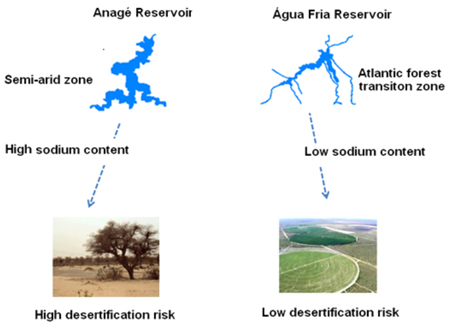
The water collected in the Anagé Reservoir during the rainy season was classified as S3 and S4, showing very high sodicity values. So it was considered inappropriate for irrigation use.
https://dx.doi.org/10.1590/S0103-50532011000800004
J. Braz. Chem. Soc. 2011, 22(8), 1426-1438
Simultaneous Regioselective Synthesis of Trifluoromethyl-Containing 1,7-Phenanthrolines and Quinolines from Cyclocondensation Reaction of N,N'-Bis(oxotrifluoroalkenyl)-1,3-Phenylenediamines
Helio G. Bonacorso; Rosália Andrighetto; Nícolas Krüger; Marcos A. P. Martins; Nilo Zanatta
How to cite this article
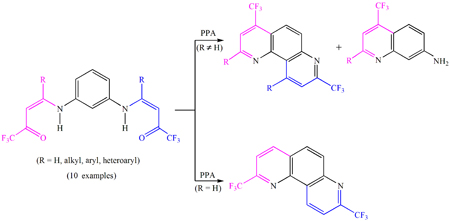
An interesting chemical behavior for cyclization reactions of a variety of enaminones was described. Selective routes of ring closure were also observed, including direct cyclocondensations, hydrolyses and recombinations, which simultaneously furnished fused bis-(trifluoromethyl)-diazatricycles and 7-aminoquinolines.
https://dx.doi.org/10.1590/S0103-50532011000800005
J. Braz. Chem. Soc. 2011, 22(8), 1439-1445
Synthesis of 1,3-Diynes via Detelluration of Bis(ethynyl)tellurides
Hélio A. Stefani; Jesus M. Pena; Julio Zukerman-Schpector; Edward R. T. Tiekink
How to cite this article

The synthesis of symmetric conjugated diyne systems with electron-withdrawing or electron-donating substituents via a palladium-catalyzed detelluration of bis(arylethynyl)tellurides and bis(alkylethynyl) tellurides is described.
https://dx.doi.org/10.1590/S0103-50532011000800006
J. Braz. Chem. Soc. 2011, 22(8), 1446-1451
Predicting Partition Coefficients of Migrants in Food Simulant/Polymer Systems using Adaptive Neuro-Fuzzy Inference System
Parviz Shahbazikhah; Mohammad Asadollahi-Baboli; Ramin Khaksar; Reza Fareghi Alamdari; Vali Zare-Shahabadi
How to cite this article
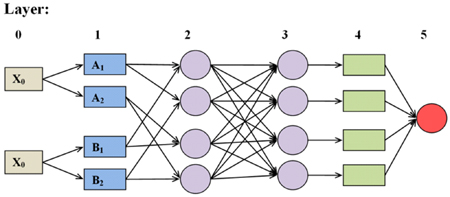
Adaptive neuro-fuzzy inference system (ANFIS) has five layers in which layers 0 and 5 represent the descriptors and response, respectively. In this study, ANFIS was employed to predict the partition coeffiction of migrants in food/packaging systems. Forty four systems consisted of 4 food stimulants, 6 migrants and 2 packaging materials were studied.
https://dx.doi.org/10.1590/S0103-50532011000800007
J. Braz. Chem. Soc. 2011, 22(8), 1452-1462
Spatial and Seasonal Variations of Pharmaceuticals and Endocrine Disruptors in the Atibaia River, São Paulo State (Brazil)
Cassiana C. Montagner; Wilson F. Jardim
How to cite this article
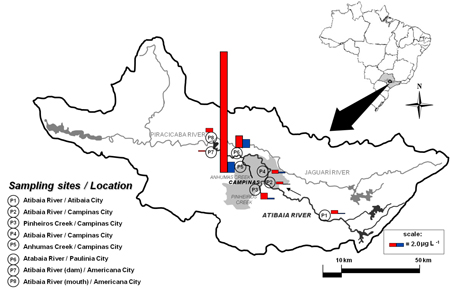
Map of the study area showing the sampling sites. Red bars account the concentrations of caffeine in the dry season and blue bars represent the concentrations of caffeine in wet season.
https://dx.doi.org/10.1590/S0103-50532011000800008
J. Braz. Chem. Soc. 2011, 22(8), 1463-1469
Utilization of a Novel Ag(III)-Luminol Chemiluminescence System for Determination of d-Penicillamine in Human Urine Samples
Li Ma; Mengdi Fan; Xiangdong Xu; Weijun Kang; Hongmei Shi
How to cite this article
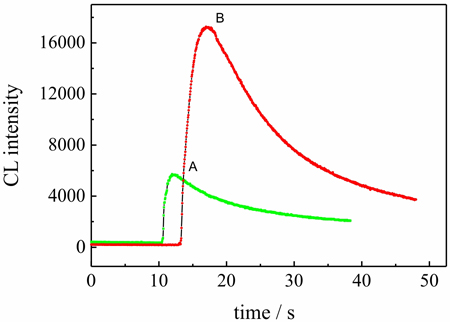
d-Penicillamine can dramatically enhance the chemiluminescence(CL) intensities of the novel reaction system: the reaction between Ag(III) complex with luminol. Chemiluminescence spectra: A, Luminol- [Ag(HIO6)2]5- system; B, d-Penicillamine-luminol-[Ag(HIO6)2]5- system.
https://dx.doi.org/10.1590/S0103-50532011000800009
J. Braz. Chem. Soc. 2011, 22(8), 1470-1477
Evaluation of a PVC Sensing Phase for Determination of Chlorinated Hydrocarbons in Water by Mid-Infrared Spectroscopy
Andréa Monteiro S. Silva; Eduardo de Araujo Viana; Maria Fernanda Pimentel; Yeda M. B. Almeida; Ivo M. Raimundo Jr
How to cite this article
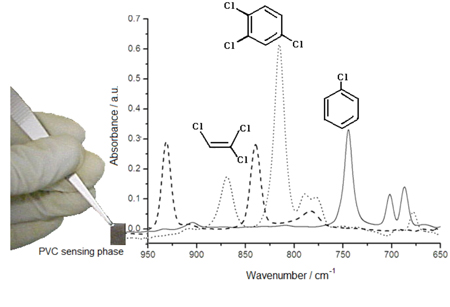
PVC sensing phase used for extraction of hydrocarbons from water and the absorption spectra obtained for chlorobenzene, trichloroethylene and trichlorobenzene.
https://dx.doi.org/10.1590/S0103-50532011000800010
J. Braz. Chem. Soc. 2011, 22(8), 1478-1483
Aspects of Protonation and Deprotonation of Humic Acid Surface on Molecular Conformation
Alexandre G. S. Prado; Jonas Pertusatti; Alécio R. Nunes
How to cite this article
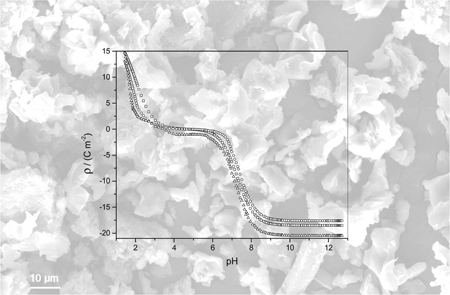
The comprehension of pH dependence on charge behavior around surfaces is important in order to control the colloidal stability of dispersion. Around a charged surface in aqueous solution, a diffuse electric double layer takes place, which protects the charge and let all the system uncharged.
https://dx.doi.org/10.1590/S0103-50532011000800011
J. Braz. Chem. Soc. 2011, 22(8), 1484-1492
Distribution and Availability of Copper, Iron, Manganese and Zinc in the Archaeological Black Earth Profile from the Amazon Region
Cleide S. T. Mescouto; Vanda P. Lemos; Heronides A. Dantas Filho; Marcondes L. da Costa; Dirse C. Kern; Kelly G. Fernandes
How to cite this article
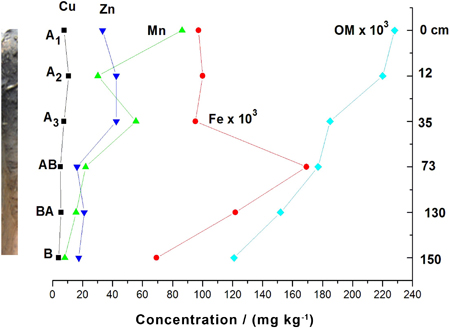
Availability of micronutrients (Cu, Fe, Mn and Zn) and organic matter (OM) showing the relationship between their concentrations along the soil profile at an archaeological site Terra Preta 2, district of Juruti, Pará State.
https://dx.doi.org/10.1590/S0103-50532011000800012
J. Braz. Chem. Soc. 2011, 22(8), 1493-1504
Assessment of Surface Water in Two Amazonian Rivers Impacted by Industrial Wastewater, Barcarena City, Pará State (Brazil)
Marcelo de O. Lima; Elisabeth C. O. Santos; Iracina M. de Jesus; Adaelson C. Medeiros; Kelson do C. F. Faial; Cláudio N. Alves
How to cite this article
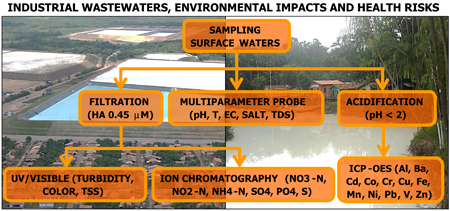
The wastewaters discharge into the Curuperê River from the industrial processing of kaolin at Barcarena City at Pará State (Brazil) caused changes in abiotic conditions also affecting the Dendê River. Environmental impacts from the analyses of the physicochemical characterization and metal levels obtained for surface waters of both rivers were observed.
https://dx.doi.org/10.1590/S0103-50532011000800013
J. Braz. Chem. Soc. 2011, 22(8), 1505-1510
Improved Synthesis of 1,3,4-Thiadiazolium-2-phenylamines using Microwave and Ultrasound Irradiation and Investigation of their Cytotoxic Activity
Camilla Moretto dos Reis; Juliana Echevarria-Lima; Amanda Fraga Miranda; Aurea Echevarria
How to cite this article

A new and efficient synthesis of eight 1,3,4-thiadiazolium-2-phenylamine derivatives was realized using microwave and ultrasound irradiation. The target compounds were obtained in good yields and remarkably short times. The cytotoxicity against K562 human leukemia and Daudi lymphoma lines was also evaluated.
https://dx.doi.org/10.1590/S0103-50532011000800014
J. Braz. Chem. Soc. 2011, 22(8), 1511-1518
Chemotaxonomical Aspects of Lower Cretaceous Amber from Recôncavo Basin, Brazil
Ricardo Pereira; Ismar S. Carvalho; Antonio Carlos S. Fernandes; Débora A. Azevedo
How to cite this article
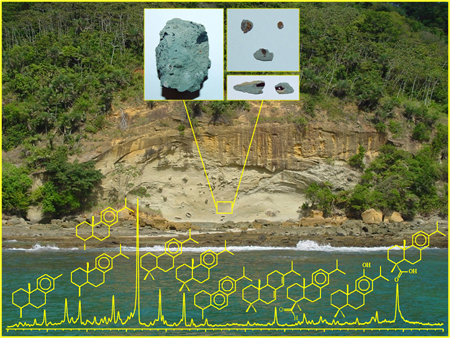
Chemotaxonomical studies concerning terpenoid composition of Brazilian amber samples allowed proposing the existence of a resinous paleoflora constituted by conifer families associated to Maracangalha Formation (Recôncavo Basin). The amber occurrence described here is evidence about the distribution of conifers in Brazil during Lower Cretaceous.
https://dx.doi.org/10.1590/S0103-50532011000800015
J. Braz. Chem. Soc. 2011, 22(8), 1519-1524
Alternative Analytical Method for Metal Determination in Inorganic Fertilizers Based on Ultrasound-Assisted Extraction
Alexandre F. Lima; Eduardo M. Richter; Rodrigo A. A. Muñoz
How to cite this article
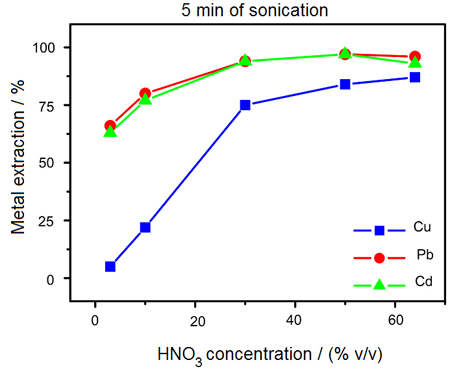
The development of a "green" sample preparation procedure for the analysis of inorganic fertilizers based on ultrasound-assisted extraction using an ultrasonic bath is described. Samples were sonicated for 5 min in the presence of 2 mL of 50% (v/v) HNO3 inside glass tubes and satisfactory recovery values were obtained.
https://dx.doi.org/10.1590/S0103-50532011000800016
J. Braz. Chem. Soc. 2011, 22(8), 1525-1530
Multiclass MSPD Method for Pesticide Determination in Dehydrated Hyptis pectinata (Sambacaitá) Medicinal Plant by GC-MS
Adriano Aquino; Michel R. R. Souza; Samia T. A. Maciel; Marcelo da Rosa Alexandre; Sandro Navickiene
How to cite this article
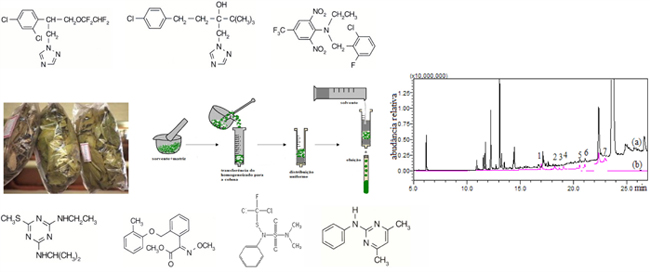
Medicinal plants are liable to contain pesticides that may accumulate from agricultural practices. The MSPD is a technique used for the extraction of analytes from solid or viscous samples. The determination of pesticides in medicinal plant is accomplished using gas chromatographic technique.
https://dx.doi.org/10.1590/S0103-50532011000800017
J. Braz. Chem. Soc. 2011, 22(8), 1531-1538
Eugenia neonitida Sobral and Eugenia rotundifolia Casar. (Myrtaceae) Essential Oils: Composition, Seasonality Influence, Antioxidant Activity and Leaf Histochemistry
Anna C. A. Defaveri; Alice Sato; Leandro B. Borré; Daniel L. M. Aguiar; Rosane A. S. San Gil; Rosani C. O. Arruda; Carlos A. S. Riehl
How to cite this article
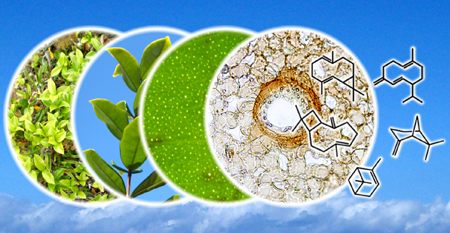
The graphical abstract shows the morphology of Eugenia neonitida in its habitat and the secretory cavities that accumulate the essential oil and from which it volatilizes. The chemical structures are α-pinene, β-pinene, β-caryophyllene, germacrene D and bicyclogermacrene, the major compounds of both studied species essential oils.
https://dx.doi.org/10.1590/S0103-50532011000800018
J. Braz. Chem. Soc. 2011, 22(8), 1539-1548
Supramolecular Complexes Formed by the Association of Poly(ethyleneimine) (PEI), Sodium Cholate (NaC) and Sodium Dodecyl Sulfate (SDS)
Arlindo C. Felippe; Ismael C. Bellettini; Renato Eising; Edson Minatti; Fernando C. Giacomelli
How to cite this article
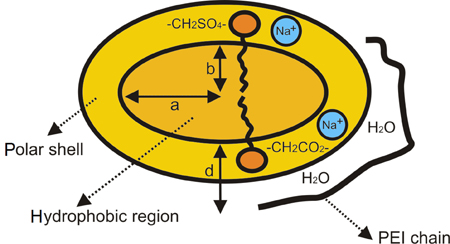
The image of the graphical abstract cartoons the formation of supramolecular complexes produced by the association of poly(ethyleneimine) (PEI) and mixtures of sodium cholate (NaC) and sodium dodecyl sulfate (SDS). The formation of such complexes has been investigated by using a variety of techniques and the results are given in this article.
https://dx.doi.org/10.1590/S0103-50532011000800019
J. Braz. Chem. Soc. 2011, 22(8), 1549-1558
A Multi-Walled Carbon Nanotube-Modified Glassy Carbon Electrode as a New Sensor for the Sensitive Simultaneous Determination of Paracetamol and Tramadol in Pharmaceutical Preparations and Biological Fluids
Ali Babaei; Ali Reza Taheri; Mohammad Afrasiabi
How to cite this article
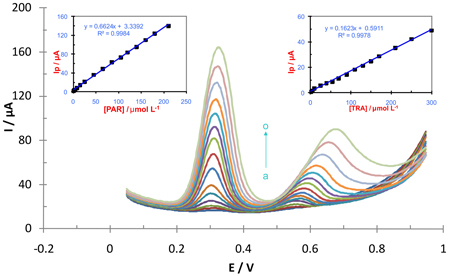
Differential pulse voltammograms and the corresponding calibration curves obtained for various concentrations of paracetamol and tramadol at a multi-walled carbon nanotube-modified glassy carbon electrode under optimum conditions.
https://dx.doi.org/10.1590/S0103-50532011000800020
J. Braz. Chem. Soc. 2011, 22(8), 1559-1567
Enantioselective Resolution of (R,S)-1-Phenylethanol Catalyzed by Lipases Immobilized in Starch Films
Isabel Hoffmann; Vanessa D. Silva; Maria da G. Nascimento
How to cite this article
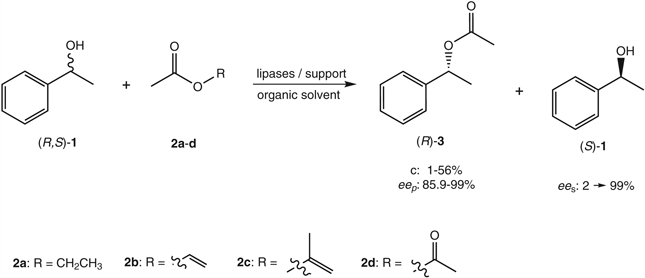
Lipases from different sources were immobilized on ginger starch film or ginger starch/PEO blends. These biocatalytic systems were used in the resolution of (R,S)-phenylethanol with vinylacetate, ethyl acetate, iso-propenyl acetate and acetic anhydride.
https://dx.doi.org/10.1590/S0103-50532011000800021
J. Braz. Chem. Soc. 2011, 22(8), 1568-1584
Hyphenating the Curtius Rearrangement with Morita-Baylis-Hillman Adducts: Synthesis of Biologically Active Acyloins and Vicinal Aminoalcohols
Giovanni W. Amarante; Mayra Cavallaro; Fernando Coelho
How to cite this article
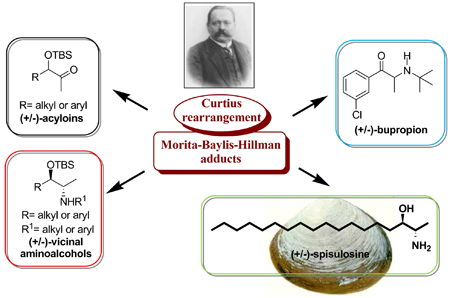
We describe herein an approach to the preparation of acyloins and anti-1,2-aminoalcohols based on a Curtius rearrangement coupled with Morita-Baylis-Hillman adducts as substrates. Based on this new approach, the total synthesis of bupropion and spisulosine were accomplished.
https://dx.doi.org/10.1590/S0103-50532011000800022
J. Braz. Chem. Soc. 2011, 22(8), 1585-1594
Input of Organic Matter in a Large South American Tropical Estuary (Paranaguá Estuarine System, Brazil) Indicated by Sedimentary Sterols and Multivariate Statistical Approach
César C. Martins; Bianca H. Seyffert; Juliana A. F. Braun; Gilberto Fillmann
How to cite this article

Cluster analyses according to general inputs (fecal, terrestrial or marine sources) in the total sterols to the sediments from Paranaguá Estuary. Group I distinguish stations where the proportion of sterols from marine sources is higher while Group II contains the stations where the fecal sterols is extremely low and terrigenous sources are slightly predominant.
https://dx.doi.org/10.1590/S0103-50532011000800023
J. Braz. Chem. Soc. 2011, 22(8), 1595-1600
Quantum Confinement in PbI2 Nanodisks Prepared with Cucurbit[7]uril
Erick M. S. dos Santos; Lourivaldo S. Pereira; Grégoire J.-F. Demets
How to cite this article
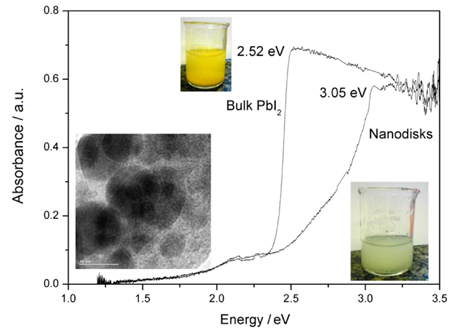
Lead iodide nanodisks were prepared using cucurbit[7]uril as a template. These nanoparticles exhibit strong absorption blue-shift as a result of one-dimensional quantum confinement.
https://dx.doi.org/10.1590/S0103-50532011000800024
J. Braz. Chem. Soc. 2011, 22(8), 1601-1609
Electrochemical Behavior of Propranolol and its Major Metabolites, 4'-Hydroxypropranolol and 4'-Hydroxypropranolol Sulfate, on Glassy Carbon Electrode
Irena Baranowska; Marta Koper
How to cite this article
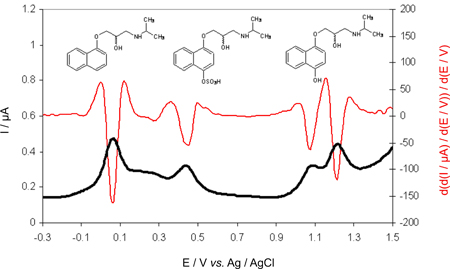
The voltammetric methods for propranolol and metabolites were proposed. The differential pulse voltammetry method on glassy carbon electrode could be used for simultaneous determination of mentioned species in urine sample after the enrichment step.
https://dx.doi.org/10.1590/S0103-50532011000800025
Short Reports J. Braz. Chem. Soc. 2011, 22(8), 1610-1615
Three New Compounds from Piper montealegreanum Yuncker (Piperaceae)
Harley da S. Alves; Maria de F. V. de Souza; Maria C. de O. Chaves
How to cite this article

The photocatalytic reforming of aqueous biomass solutions could be an interesting and innovative route to produce hydrogen in ambient conditions. This process is able to produce hydrogen from renewable energy sources, since it uses solar radiation, raw materials derived from renewable sources such as biomass and water.
https://dx.doi.org/10.1590/S0103-50532011000800026
Online version ISSN 1678-4790 Printed version ISSN 0103-5053
Journal of the Brazilian Chemical Society
JBCS Editorial and Publishing Office
University of Campinas - UNICAMP
13083-970 Campinas-SP, Brazil
Free access










